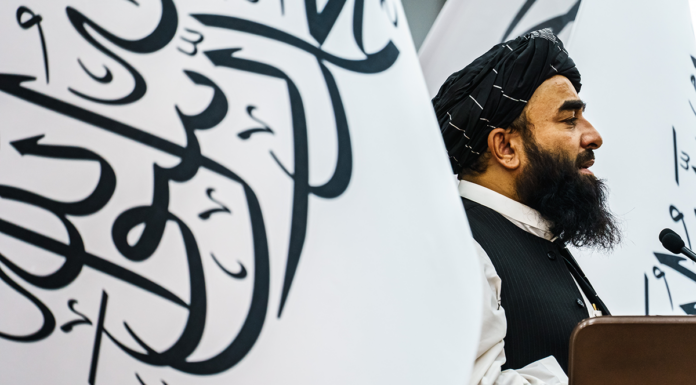
In the more than two years since the Afghan Interim Administration was established, Afghanistan’s political landscape has largely stabilized, yet a deep humanitarian crisis persists alongside sporadic terrorist attacks.
According to the United Nations, Afghanistan still hosts approximately 20 active terrorist organizations, primarily linked to the Afghan Taliban. The Islamic State Khorasan Province (ISKP) stands out as the primary adversary to the Afghan Interim Administration.
Sirajuddin Haqqani, leader of the Haqqani Network, now serves as the deputy leader of the Afghan Interim Authority and Acting Minister of the Interior. This integration has made the Haqqani Network an essential component of the Interim Authority’s intelligence apparatus.
Construction of the Afghan Interim Government’s Intelligence System
The Afghan intelligence system, which is based on the liquidation of the intelligence system of the previous government and is a continuation and development of the intelligence system of Atta’s first administration (1996-2001), consists of four main institutions: the General Intelligence Directorate, the Ministry of the Interior, the Ministry of Defense, and the Ministry for the Promotion of Virtue and the Prevention of Vice.
The former Afghan government’s intelligence apparatus primarily comprised the Afghan National Directorate of Security (NDS), established in 2002 with assistance from the U.S. Central Intelligence Agency (CIA), alongside the National Security Forces (NSF) and local police.
The Afghan National Security Forces (ANSF) encompassed the Afghan National Army (ANA), Afghan Air Force (AAF), and Afghan National Police (ANP). The ANA, established in 2002, provided various military and support functions. The AAF, formed in 2007, focused on airborne intelligence gathering and firefighting. The ANP, including the Afghan Uniformed Police (AUP), the Afghan National Civil Order Police (ANCOP), and the Afghan Border Police (ABP), maintained law and order across different regions and borders.
The Afghan Local Police (ALP), supported by the U.S. and UK, assisted the National Security Forces against insurgency. However, under Atta’s leadership, former government intelligence officers were purged, resulting in executions and forced disappearances. Many fled the country, while others went into hiding. Despite amnesties, reprisals continued, leading to a significant reduction in the former government’s intelligence capabilities.
Building the Intelligence System of this Government
The Afghan intelligence system encompasses four main agencies: the General Directorate of Intelligence (GDI), the Ministry of the Interior (MOI), the Ministry of Defense (MOD), and the Ministry for the Propagation of Virtue and the Prevention of Vice (MPPV).
The General Directorate of Intelligence (GDI), under the leadership of Abdul Haq Wasiq, operates under the supreme leadership of Hibatullah Akhundzada. It focuses on defending the regime and safeguarding cultural, religious, and property rights through human and open-source intelligence gathering methods.
The Ministry of the Interior (MOI), headed by Sirajuddin Haqqani, oversees law enforcement and public order, predominantly utilizing the intelligence network of the Haqqani Network. It maintains ties with Pakistani intelligence agencies and various terrorist organizations, facilitating intelligence sharing.
The Ministry of Defense (MOD), led by Mohammad Yaqoob, prioritizes border security and national sovereignty. Its intelligence capabilities are rooted in Atta’s traditional network, employing regional commanders and village community groups for information dissemination.
The Ministry for the Propagation of Virtue and the Prevention of Vice (MPPV), led by Sheikh Muhammad Khalid Hanafi, upholds Islamic ideology by monitoring and enforcing adherence to Islamic norms in various aspects of society. Its efforts extend to military establishments and civilian life, ensuring compliance with Islamic decrees and values.
Effectiveness of the intelligence system of the Afghan Interim Authority
The Afghan intelligence system focuses on safeguarding the Islamic regime, controlling hostile forces, aiding reconstruction, and defending Islamic ideology. It has upheld a positive image of the regime by monitoring and guiding the media and enforcing strict societal regulations.
This includes banning music, controlling protests, and imposing dress codes. Additionally, it purges and integrates former government armed forces while combating terrorists both domestically and internationally. Efforts have also been made to persuade fugitive talents to return and maintain international cooperation, particularly with Pakistan’s ISI and the US CIA.
The system has effectively maintained a positive portrayal of the Islamic regime by closely monitoring and influencing media content, enforcing stringent societal regulations such as dress codes and music bans, and suppressing dissenting voices.
It has also played a significant role in purging and integrating former government armed forces, combating terrorist groups like ISIS, and encouraging the return of skilled professionals to contribute to the nation’s development.
Furthermore, the intelligence system has actively engaged in international cooperation, notably with Pakistan’s ISI and the US CIA, to address mutual security concerns and foster diplomatic relations.
Challenges to the intelligence system of the Afghan Interim Authority
The Afghan intelligence system has made significant strides in safeguarding the Islamic regime, combating hostile forces, and aiding in post-war reconstruction over the past two years. However, it faces challenges from domestic, regional, and major powers.
Domestically, resistance from pro-democracy factions persists, with concerns over inclusivity and women’s rights. Terrorist organizations, including Al-Qaeda and ISIS-K, continue to operate with some autonomy under the regime’s umbrella, posing internal threats.
Regionally, neighboring countries like Pakistan and Iran maintain infiltration through their intelligence services. Tajikistan, in particular, expresses hostility towards the Afghan government.
Internationally, the U.S. continues to monitor and act against potential threats, while Russia and India exert pressure on the regime to combat terrorism and ensure inclusivity.
Source: Middle East Institute, Long War Journal, Intelligence Briefs



